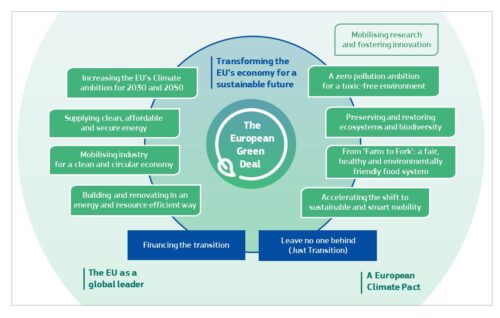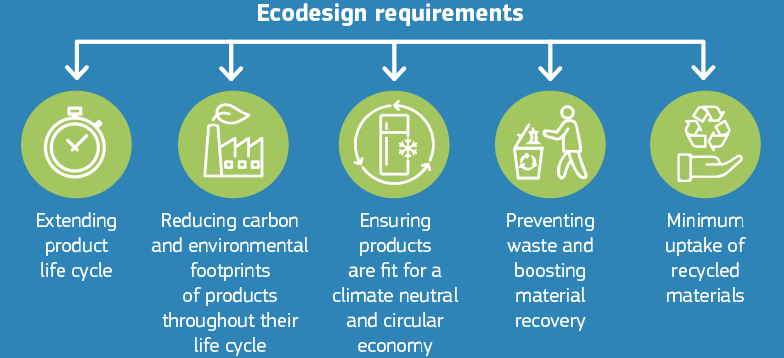The European Green Deal presents a roadmap for making the EU’s economy sustainable by turning climate and environmental challenges into opportunities across all policy areas and making the transition just and inclusive for all. The European Green Deal aims to boost the efficient use of resources by moving to a clean, circular economy and stop climate change, revert biodiversity loss and cut pollution. It outlines investments needed and financing tools available, and explains how to ensure a just and inclusive transition. The European Green Deal covers all sectors of the economy, notably transport, energy, agriculture, buildings, and industries such as steel, cement, ICT, textiles and chemicals.
The European Green Deal provides an action plan, to boost the efficient use of resources by moving to a clean, circular economy and to restore biodiversity and cut pollution. It embraces various policy areas (compare timeline to the right).
Policy areas of the EU Green Deal:

One area embraces the EU action plan for the Circular Economy (CEAP) II: The Circular Economy Package has been adopted with a view to boosting global competitiveness, fostering sustainable economic growth and generating new jobs. It consists of two EU Action Plans for the Circular Economy (2015 and 2020), with measures covering the full life cycle of products: from production and consumption to waste management and the market for secondary raw materials. Building on the work done on circular economy since 2015, the CEAP II focuses on resource intensive sectors where the potential for circularity is high. Aiming to keep resources in economic cycles as long as possible, the plan addresses key product value chains: electronics and ICT, batteries and vehicles, packaging, plastics, textiles and food.
The proposal for a Regulation on Ecodesign for Sustainable Products addresses product design, which determines up to 80% of a product’s lifecycle environmental impact. It sets new requirements to make products more durable, reliable, reusable, upgradable, reparable, easier to maintain, refurbish and recycle, and energy and resource efficient. In addition, product-specific information requirements will ensure consumers know the environmental impacts of their purchases. All regulated products will have Digital Product Passports. This will make it easier to repair or recycle products and facilitate tracking substances of concern along the supply chain. The new proposal extends the existing Ecodesign framework in two ways: first, to cover the broadest possible range of products; and second, to broaden the scope of the requirements with which products are to comply.

The Farm to Fork Strategy lays down a new approach to ensure that agriculture, fisheries and aquaculture, and the food value chain contribute appropriately to the objective for a climate neutral Union in 2050. Food systems remain one of the key drivers of climate change and environmental degradation. The manufacturing, processing, retailing, packaging and transportation of food make a major contribution to GHG emissions, air, soil and water pollution, and have a profound impact on biodiversity. On the other side, consumers also need to be empowered to choose sustainable food. The creation of a favourable environment that makes it easier to choose healthy and sustainable diets will benefit consumers’ health and quality of life, and reduce health-related costs for society.
The new 2030 Biodiversity Strategy is a comprehensive, systemic and ambitious long-term plan for protecting nature and reversing the degradation of ecosystems. It is a key pillar of the European Green Deal and of EU leadership on international action for global public goods and sustainable development goals. With an objective to put Europe’s biodiversity to recovery by 2030, the Strategy sets out new ways to implement existing legislation more effectively, new commitments, measures, targets and governance mechanisms.
The Zero Pollution Action Plan provides a compass to mainstream pollution prevention in all relevant EU policies, to step up implementation of the relevant EU legislation and to identify possible gaps. It includes targets on air, water, soil, and noise pollutions as well as waste generation and biodiversity. The Plan outlines a number of flagship initiatives and actions, targeting air, water and soil but also reviewing EU waste laws and reducing the EU’s external pollution footprint by restricting the export of products and wastes that have harmful, toxic impacts in third countries (among others).
The proposed revision of the EU legislation on Packaging and Packaging Waste aims to put an end to wasteful packaging, boosting reuse and recycling. It has as three main objectives. First, to prevent the generation of packaging waste: reduce it in quantity, restrict unnecessary packaging and promote reusable and refillable packaging solutions. Second, to boost high quality (‘closed loop’) recycling: make all packaging on the EU market recyclable in an economically viable way by 2030. And finally, to reduce the need for primary natural resources and create a well-functioning market for secondary raw materials, increasing the use of recycled plastics in packaging through mandatory targets.For consumers, they will ensure reusable packaging options, get rid of unnecessary packaging, limit overpackaging, and provide clear labels to support correct recycling. For the industry, they will create new business opportunities, especially for smaller companies, decrease the need for virgin materials.
The Proposal for a new Regulation to curb EU-driven deforestation and forest degradation sets strong mandatory due diligence rules for companies that want to place relevant products on the EU market or export them. Operators and traders will have to prove that the products are both deforestation-free (produced on land that was not subject to deforestation after 31 December 2020) and legal (compliant with all relevant applicable laws in force in the country of production). Companies will also be required to collect precise geographical information on the farmland where the commodities that they source have been grown, so that these commodities can be checked for compliance. The list of commodities that are covered will be regularly reviewed and updated, taking into account new data such as changing deforestation patterns.